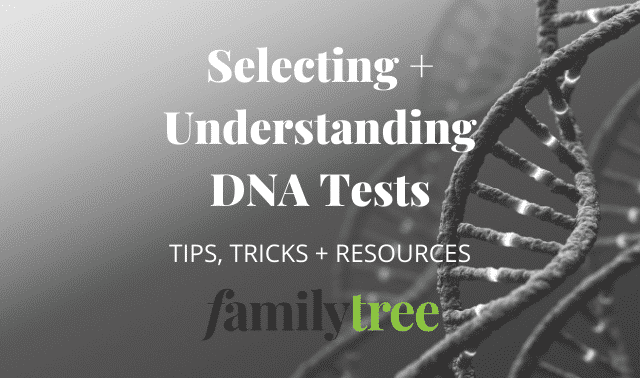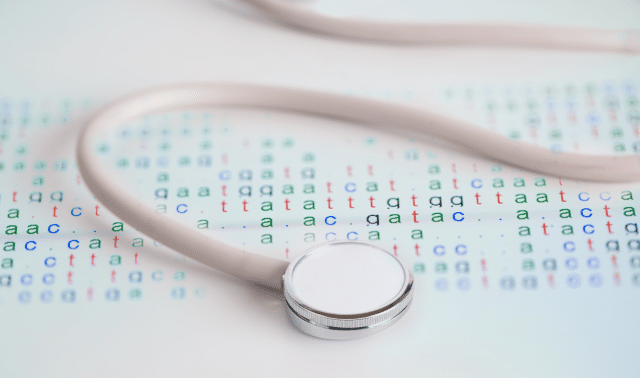Sign up for the Family Tree Newsletter Plus, you’ll receive our 10 Essential Genealogy Research Forms PDF as a special thank you!
Get Your Free Genealogy Forms
"*" indicates required fields

Plenty of us genealogists have thought about trying genetic genealogy testing in hopes of finally breaking through a persistent research brick wall. But then we freeze like a kid with test anxiety: Would it really help? What kind of test would I need? And where do I even begin?
I had those questions, too—and more—before my dad and I entered the world of genetic genealogy testing last fall (I needed Dad for his Y-DNA). When I was in college, I wanted to be a genetic counselor. Fast forward a decade and I found myself, now a stay-at-home mom, leaning on that background in biology and genetics. I had to brush up and re-read information from any source I could lay my hands on, all so I could wrap my head around all the advancements in the ever-broadening field of genetic genealogy.
There’s no need to agonize over DNA testing decisions. Let my homework benefit you: Use the tips, suggestions and explanations I’ve picked up as your own genetic genealogy cheat sheet.
https://www.youtube.com/watch?v=LrmsPOb05pc
1. Have a basic understanding of DNA test terms and choices.
Having a basic understanding of the terms and choices is a must before ordering your test. Many of the books on genetic genealogy were published five or more years ago, but still provide you with the building blocks to understand the genetic genealogy field as it is today. The two I found most helpful are Trace Your Roots with DNA by Megan Smolenyak and Ann Turner (Rodale) and DNA and Genealogy by Colleen Fitzpatrick and Andrew Yeiser (Rice Book Press).
Take advantage of the web, too. Many sites are specific to certain DNA surname or community research projects, but you’ll find plenty with FAQs and general information. A few I recommend are:
- International Society of Genetic Genealogy (ISOGG), which provides education and support for those using genetic genealogy as a research tool
- Journal of Genetic Genealogy, an online magazine
- Guild of One-Name Studies, which focuses on one-name, or surname, DNA studies
You’re more of a blog reader? You’re in luck. The ISOGG has an extensive list of blogs written by members, institutions and people like you and me. Two I particularly like are:
- The Genetic Genealogist by Blaine T. Bettinger, whose name you may recognize from his contributions to Family Tree Magazine. Bettinger has a PhD in biochemistry with a concentration in genetics, and writes about new developments in the field in an understandable way.
- Your Genetic Genealogist by CeCe Moore, who stays in touch with several testing companies and works with ISOGG to help people understand their test results. She also explains the tests and analyses available.
2. Have a clear purpose before you order a DNA test.
If you don’t have a clear purpose in your head before you order your genetic test, the process can be a real letdown. Many tests and analyses are available, each one a little different from another (but somehow all sounding similar). Knowing what you want to discover—say, where your maternal roots lie or whether you’re related to your genealogy buddy of the same surname—is essential to picking the right test for you.
Another determining factor is which family line, paternal or maternal, you want to find out about. You might already know you can test both of the sex-determining chromosomes, X and Y. Y-DNA tests trace the Y-chromosome, which is passed from father to son, and reveal information about a person’s male lineage—father, grandfather, great-grandfather, etc.—and any male-line descendants of these men. Only men can take this test, but a woman wanting to trace male lineage could enlist the help of her brother, father, father’s brother, father’s brother’s son, or other male-line relative
Mitochondrial DNA (mtDNA) tests look at mitochondrial DNA, which mothers pass on to sons and daughters—so both men and women can take this test. A man inherits one X chromosome from his mother; a woman inherits one X chromosome from her mother and one from her father (which he received from his mother). It can be complicated to follow, but because of this inheritance pattern, you can trace maternal ancestry in both sides of your family through mtDNA.
For a more general test that has the potential to give you information on any of your family lines, there’s the auto-somal DNA test. This test analyzes all the chromosomes you’ve inherited from both parents, so both men and women can take it. Due to the way genes are inherited, most people will find reliable results for five generations back. But remember that genetic science can’t yet tell you which chromosome came from which ancestor
Let’s look at what my father and I decided on. I talked him into participating in a surname study, a project to analyze genetic results of people with the same last name, or variations of it. For instance, variants in the Combs surname study include Coombs, Combes, Coombes, Coomes and others.
Dad and I both wanted to know if family stories of Scottish ancestors were true, and we were hoping to find a relative—perhaps a cousin who’d figured out where in Virginia my father’s third-great-grandfather Charles Combs came from. Because Dad is a male-line descendant of Charles, they have the same Y-DNA (barring any mutations or “nonpaternity events”). I ordered a Y-DNA test to learn the genetic fingerprint of Dad’s paternal line.
When you decide on a testing company, you’ll learn which DNA markers they test. We needed to test the specific markers selected when the Combs surname study was set up. If you join a surname study but you don’t go with its recommended testing company, find out which markers you should test so you can compare your results to the other participants. (You may be able to order tests on individual markers a la carte, as I did.) Also, if a relative has already taken a DNA test, consider using the same company for easy comparison.
Study the company’s website, call to ask your questions, and make sure you understand what kind of analysis your test includes.
3. Read the instructions completely to make sure you get a good sample.
Waiting for the test kit to arrive is almost as exciting as waiting for the results. Each company’s kit is a bit different, but the main components are the same: several swabs and tubes, instructions and a release form. You also may get a pre-addressed envelope to return the samples. Read the instructions completely to make sure you get a good sample for the test. For guidance, use online videos and tutorials such as Family Tree DNA’s four-minute demo on YouTube.
Once you send in your sample, the DNA is isolated and lab technicians sequence, amplify and measure the DNA. The lab then analyzes the measurements to gather information, including your marker values, haplotype and haplogroup.
The testing company will give you a timeline on when to expect your results. Generally, you’ll receive them by mail or online within four to six weeks. It seems like an eternity, I know, but think about all the other genealogy-related to-dos you could check off your list in that time.
4. Create a spreadsheet to keep numbers organized.
The wait is over: You’ve received your test results. If you’re like me, you’re staring at them and thinking, “What in the world do all these numbers mean?” All those classes in genetics did nothing to help me understand what I was looking at. Thankfully, I had the wonderful woman in charge of the DNA surname study to walk me through it, and the world’s knowledge at my fingertips with the internet and my books.
My dad had only 27 of the markers tested that the surname study uses, but I could order tests for individual markers. We didn’t even need to provide a new sample. Most labs can continue to use the original sample, making copies as needed.
To wrap my head around the numbers and keep potential relatives in order, I created a spreadsheet for my dad’s results. I set up a column for each marker and entered his values for that marker (see the box on the previous page for an example). As potential matches who found me through the testing company’s database contacted me, it was easy to enter their results on the same markers and compare them to Dad’s.
Differences in markers indicate DNA mutations, which occur naturally as cells replicate over millennia. When you compare these mutations, you can determine how closely related you are with someone—see the previous page for more on how I analyzed my dad’s test results.
Besides results for each marker, you’ll also learn your haplogroup. Haplogroups consist of similar haplotypes, which can show you the geographic area where your paternal or maternal line originated (depending whether you tested Y-DNA or mtDNA).
5. Explore ways to use your DNA test results.
Once you’ve made some sense of all those numbers, you’re ready to use your results. If you’re doing a surname study, work with the administrator to analyze the results in the context of the rest of the group. He or she can tell you about any matches, other interesting findings, and further testing you may want to pursue.
Take the time to get familiar with the testing company’s website, features and forums. On Ancestry.com, for example, you can link your Ancestry tree to your test results and view an interactive map of your results and ancestral birthplaces. Family Tree DNA and 23andMe let you download raw data for your markers so you can perform advanced analysis.
Most important, start incorporating your results into your genealogy research. Genetic testing can open up new possibilities in tracing your roots, but it doesn’t always give you the definitive answers you want. That was the case for us. The initial results made us hopeful my dad’s line originated in Dorset, England. But we couldn’t get excited because a surprise might be waiting in those extra marker tests—such as large value differences in those markers. And unfortunately, he doesn’t match anyone in the testing company’s or surname study’s database. His closest match is still the Dorset line of Combses. Of the 43 markers, we had mutations at six, giving him a genetic distance of 11 from the other men—see the box to find out why this isn’t a sure match.
Where does this leave us? Dad’s test results are logged in the surname study database and on the testing company’s site. Think of doing genetic genealogy as putting a family tree online: You’ve opened the door for potential relatives to find you. We hope one day a cousin will submit results that match my dad’s, and we’ll be able to target our research in records to places where our family trees intersect. And now that the DNA bug has bitten me, I want to have my mom, husband and perhaps some cousins tested. Imagine what I could find out about our past and the different research roads I could follow.
Unscrambling the DNA Code
Trying to understanding DNA test results can make anyone anxious, but it’s actually simple once you understand the code. Let’s look at a sample result for a Y-DNA test. Say your test results report “Marker DYS393, Value 13.” Here’s what those numbers and letters mean:
- D = DNA
- Y = Y chromosome
- S = a unique segment
- 393 = identifying number for this unique segment
- Value = how many times that marker repeats
So translated, DYS393, Value 13, means that the DNA from the Y chromosome on segment 393 repeats 13 times.
When you find a potential match in a DNA results database, you’ll compare your values to that person’s values. If there’s a different value for a certain segment, you can calculate the genetic distance. The smaller the genetic distance, the better.
In the Y-DNA analysis table at right, note the differences in the marker values at DYS447 and DYS449. To get the genetic distance between these test-takers, subtract the values from each other and then add up the differences: 25-20=5 and 31-29=2, and 5+2=7, giving us a genetic distance of 7.
What does this mean? If you tested 25 markers on the Y chromosome, you’d want a distance ranging from 0 (a perfect match) to 2 to be able to say you’re related. Any greater distance means you’re likely not related. The more markers you test, the greater the genetic distance can be and still indicate a relationship: In a test of 37 markers, you can see a genetic distance of up to 6 and still be considered related.
Your mtDNA results read a little differently—they come as a string of sequenced nucleo-tides, not the number of alleles for a specific marker. The test looks at the two parts of mtDNA: the control regionor hypervariable region (HVR), and the coding region. The control region is subdivided into the HVR1 and HVR2, and has a higher mutation rate. The coding region changes more slowly and is used to define mitochondrial haplogroups. MtDNA results are compared to what’s called the Cambridge Reference Sequence (CRS), and differences, or mutations, are noted.
Mutations can include changes, insertions or deletions of nucleotides. See the mtDNA analysis table below: There’s a change at locus 401, a deletion at 407, and an insertion at 415 which would be labeled 415.1A (415 is the locus, .1 is the insertion number and A is the nucleotide inserted).
The more differences, the further away your most recent common ancestor (MRCA). If you and your potential cousin match on HVR1, there’s a 50 percent chance of having an MRCA in the last 52 generations. A match on HRV1 and HRV2 brings that chance to 50 percent within the last 28 generations. If you match on the full sequence, there’s a 50 percent chance an MRCA lived within the last five generations.
A version of this article appeared in the December 2012 issue of Family Tree Magazine.
Related Reads
ADVERTISEMENT









